Keep reading to learn what ecommerce SEO is, why it’s important, and how to master it.
Ecommerce SEO is the process of optimizing an online store to improve its visibility and rankings in search engines like Google. It focuses heavily on improving the performance of category and product pages, as these tend to be the most lucrative.
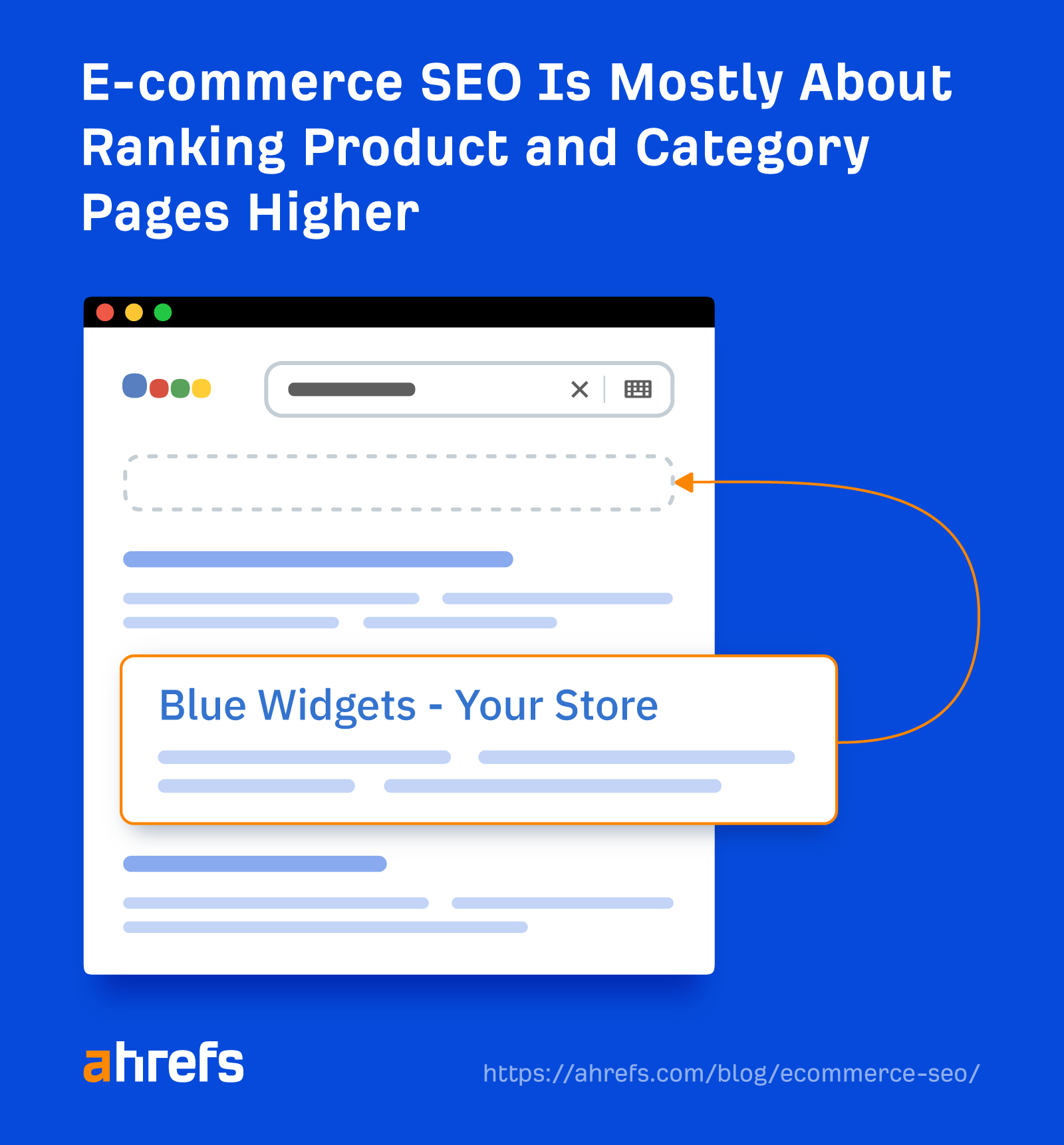
It’s generally a more cost-effective way to reach your customers rather than bidding on expensive paid advertising keywords.
Technical SEO may seem the most daunting starting point, but it’s crucial for ecommerce sites. That’s mainly because of issues relating to faceted navigation, but there are also a few things to keep in mind. Let’s go through them.
Secure your site with HTTPS
HTTPS is a secure protocol for transferring data between websites and visitors. It prevents hackers from stealing sensitive information that visitors commonly share with online stores, such as their name, address, and credit card details.
It’s also been a minor Google ranking factor since 2014.
You’ll know if your store uses HTTPS because it’ll have a “padlock” icon in the address bar that looks like this:

Most popular ecommerce platforms use HTTPS, so it shouldn’t be a concern for most people. But if it is, make sure to fix it.
Make your site structure easy to navigate
Site structure is how your website’s pages are organized and interlinked.
Most ecommerce stores organize their pages roughly like this:
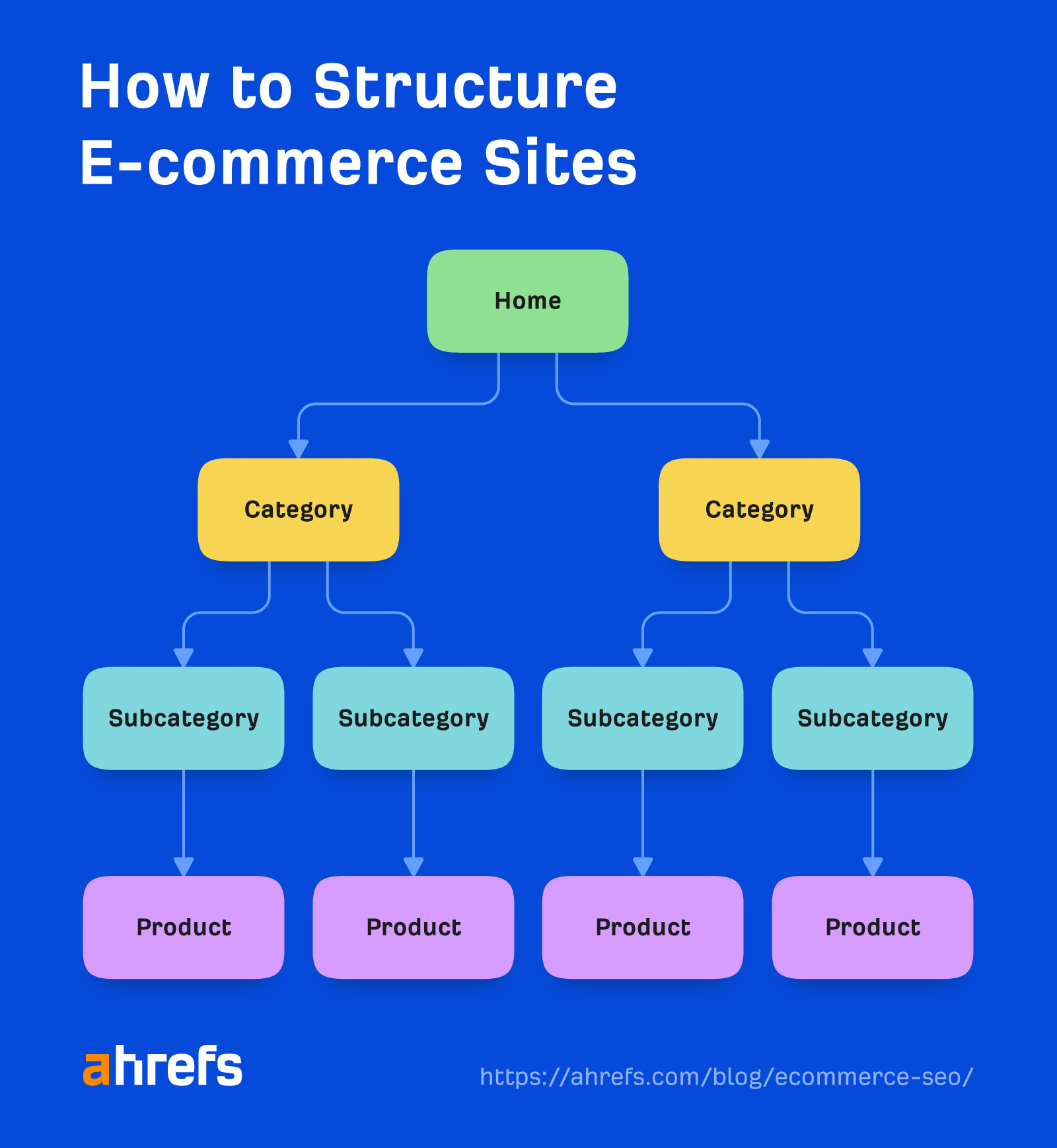
Here are two reasons why this structure makes sense:
- It’s easy to navigate your ecommerce site architecture – Visitors can find what they’re looking for in just a few clicks.
- It helps Google and other search engines find your pages – Google can “follow” internal links from page to page.
Getting your site architecture right from the start also means you’ll avoid the headache of redesigning your site structure later on.
When it comes to internal links, it’s best to keep it simple to start with. You can use the arrows in the illustration above as guidance on how to interlink your pages.
For example, your homepage should link to your category pages, which should link to the relevant subcategory pages, which should link to the relevant products.
Implement faceted navigation correctly to give your pages the best chance at ranking well
Faceted navigation allows visitors to filter the products on category and subcategory pages.
Here’s what it looks like:

Despite its usefulness for visitors, it can cause serious SEO issues for ecommerce websites because filter combinations often create new parameterized URLs.
For example, if you filter for on-ear headphones, it may create a URL like this:
/headphones/?color=red&brand=sony&type=wired
Even if you only have a handful of filters, there can be thousands of combinations. That means thousands of new URLs that Google can end up crawling and potentially indexing.
That isn’t good because it can:
- Weaken important pages’ ability to rank – Filter combinations can often lead to the creation of multiple URLs with the same content. Unless Google realizes this (which doesn’t always happen), ranking signals will get split between the duplicate pages.
- Prevent Google from crawling important pages – Google will only devote finite resources to crawling your site. If it has to crawl a load of junk, it may not have the resources to crawl all important pages.
There are various solutions to these issues. For beginners and intermediates, a simple option is to canonicalize faceted URLs to their master category or subcategory.
Some ecommerce SEO platforms do this out of the box. Check if this is the case for your site by installing Ahrefs’ SEO Toolbar, visiting a few faceted URLs, and checking the “Indexability” tab. If the canonical URL is non-faceted, chances are this isn’t an issue on your site.
Here’s an example of this in action:

Keyword research helps you find relevant keywords and understand how people search for what you sell. You can use this knowledge to create category pages, subcategory pages and product pages on your ecommerce site that cater to search demand. Let’s look at how to do this.
Get keyword ideas for subcategory pages with keyword research
Subcategory pages show the types of products you sell in a category.
For example, a “headphones” category may have subcategories like “wired” and “wireless.”
You probably already know some subcategories that make sense for your store. But as people search in many ways, it’s useful for SEO to create subcategories that align with those terms.
Here’s how to find ideas for subcategories in Ahrefs’ Keywords Explorer:
- Enter a few broad keywords related to your category
- Go to the Matching terms report
- Look for the types of things you sell
Here are a few ideas for the “headphones” subcategories:

Note that this isn’t all about search volumes. You should use common sense and choose terms that make sense as subcategories.
For example, “audio technica open ear headphones” won’t be a suitable subcategory because it’s too specific. The same is true for “bone conduction headphones” unless you sell more than a couple of pairs.
Here’s a quick cheat sheet for choosing subcategories for SEO:

Repeat the process for other categories.
Find keywords for product pages with keyword research
Ecommerce keyword research for products isn’t really a thing if you sell branded products, as people will search for the products themselves.
For example, there are an estimated 622K monthly searches in the U.S. for “airpods pro.”

If you sell these headphones, your product page already targets that keyword.
However, if you’re selling unbranded products or products from unknown names, you may want to find and target more descriptive terms that people search for.
For example, let’s say you sell a pair of cat ear headphones. Unless people are specifically searching for the brand or model, it may be better to target a relevant keyword that people actually search for, such as “cat ear headphones.”

Keep search intent in mind when doing this. If the top search results for a keyword are all ecommerce category pages, this may indicate that searchers want a choice. In this case, it may be better to target the keyword with a subcategory page or faceted URL (more on those later).
On-page search engine optimization is the process of optimizing the content on your page. It includes optimizations to the content you see and code under the hood. Let’s go through a few considerations and optimizations for ecommerce sites.
Save time with title tag, meta description, and H1 templates
Most ecommerce stores use templates for their title tags and meta descriptions.
Here’s an example of a meta description template.

Using a templated approach makes sense because writing unique copy for thousands of product and category pages is nobody’s idea of fun. Unfortunately, it can lead to stale, duplicate copy that doesn’t entice clicks.
You can solve this with a hybrid approach where you use templates for most pages but unique ones for those with the most search traffic.
Here’s how to find pages with the most search traffic in Google Search Console (GSC):
- Go to the Search results report
- Select the “Pages” tab

If you don’t use GSC, you can get a free estimate in Ahrefs’ Site Audit with an Ahrefs Webmaster Tools account.
- Select your project in Site Audit
- Go to the Page Explorer
- Filter for internal pages
- Sort by organic traffic from highest to lowest

For H1s, it’s simple—just use the category or product name.

Use simple and descriptive URLs that are SEO friendly
Here’s a simple template that works for category and subcategory pages:
domain.com/category/subcategory/
For example, here are a few categories and subcategories for our audio store that follow this template:
domain.com/headphones/ domain.com/headphones/wireless domain.com/headphones/wired domain.com/headphones/over-ear domain.com/headphones/in-ear
Things are a little more complicated when it comes to products because the obvious structure will be this:
domain.com/category/subcategory/product
However, as products often fall into multiple categories, this can lead to duplicate content. In other words, the same product is available at various URLs.
For example, AirPods are both wireless and in-ear headphones, so they’ll end up with two URLs:
domain.com/headphones/in-ear/airpods domain.com/headphones/wireless/airpods
You can solve this problem by using this template for product URLs:
domain.com/product
Use keyword research to add unique product and category descriptions to help visitors and search engines
Product and category pages often have little to no content. That isn’t necessarily bad for search engine optimization, but adding unique descriptions with ecommerce keyword research can help search engines and visitors better understand your product and category pages.
Here are a few tips for doing this:
- Keep them short and sweet
- Make sure they’re descriptive and helpful
- Mention long-tail keywords
To find long-tail variations and synonyms, plug a competing product or category page for your main target keyword into Ahrefs’ Site Explorer and check the top 10 rankings in the Organic keywords report.

For example, here are a few notable keywords that one of the top-ranking pages for “wireless headphones” also ranks for:
- bluetooth headphones
- wireless earphones
- bluetooth earbuds
It will be easy and natural to mention these words in the page’s description.
Link building for ecommerce stores is hard because there’s usually no value for someone else to link to a product or category page. However, there are a few tried and tested methods. You can also use other methods to get links to your homepage. Let’s go over a few link building techniques you can use as part of your ecommerce SEO strategy.
Use the “product feedback” technique to get featured
If you have products that only you sell, the “product feedback” technique can help you get featured on lists of the best products in that category.
Here’s the process:
- Find popular lists of the best products
- Offer the author your product in return for feedback
- Ask them to consider including it on their list (if they like the product)
Given that most authors will link to the products they feature, this is a straightforward way to build links directly to product pages.
To find lists of the best products that don’t mention yours, search Google for best[product category] -brandname.
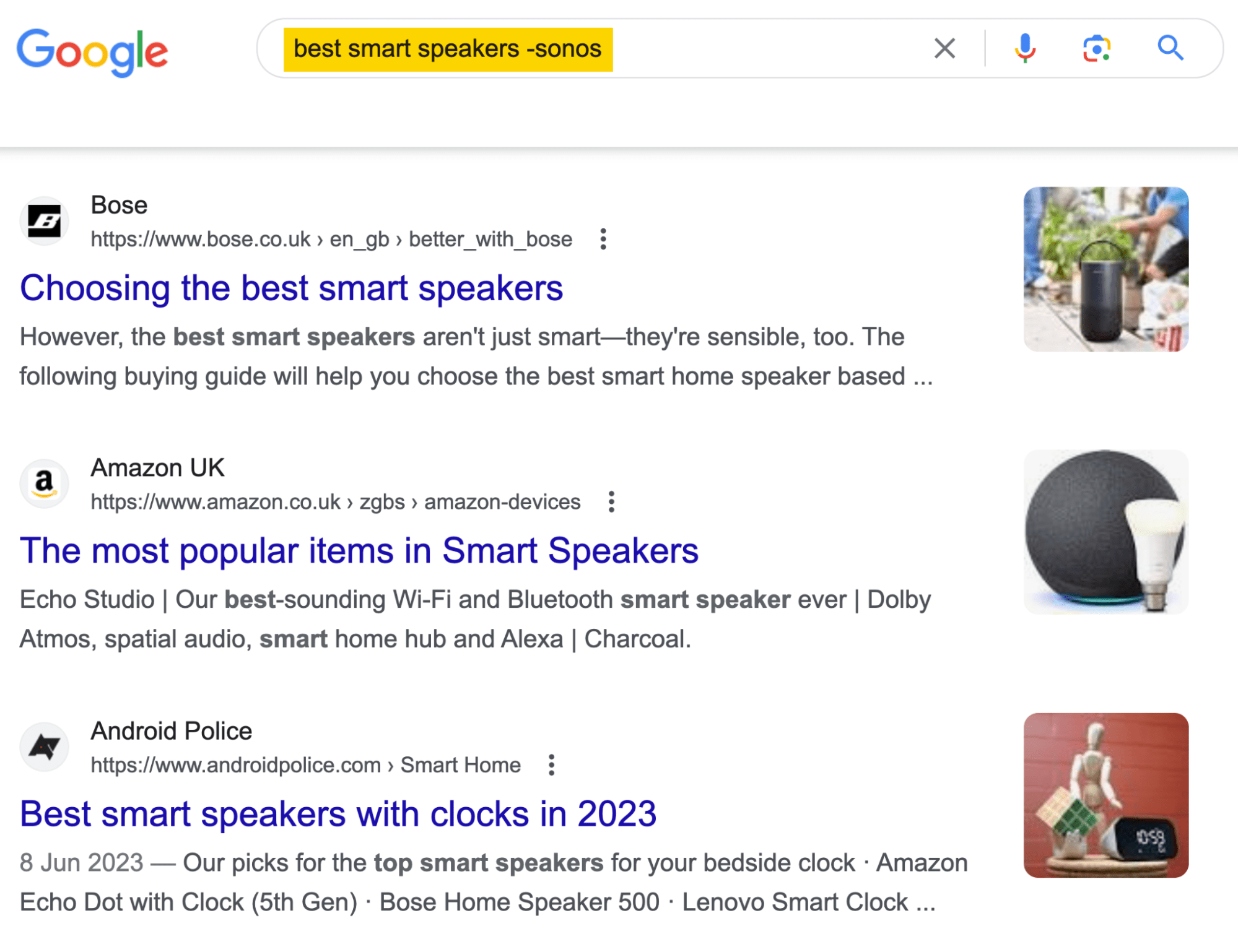
Alternatively, run an “In title” search in Ahrefs’ Content Explorer for the same thing and filter for pages with traffic to find popular lists.
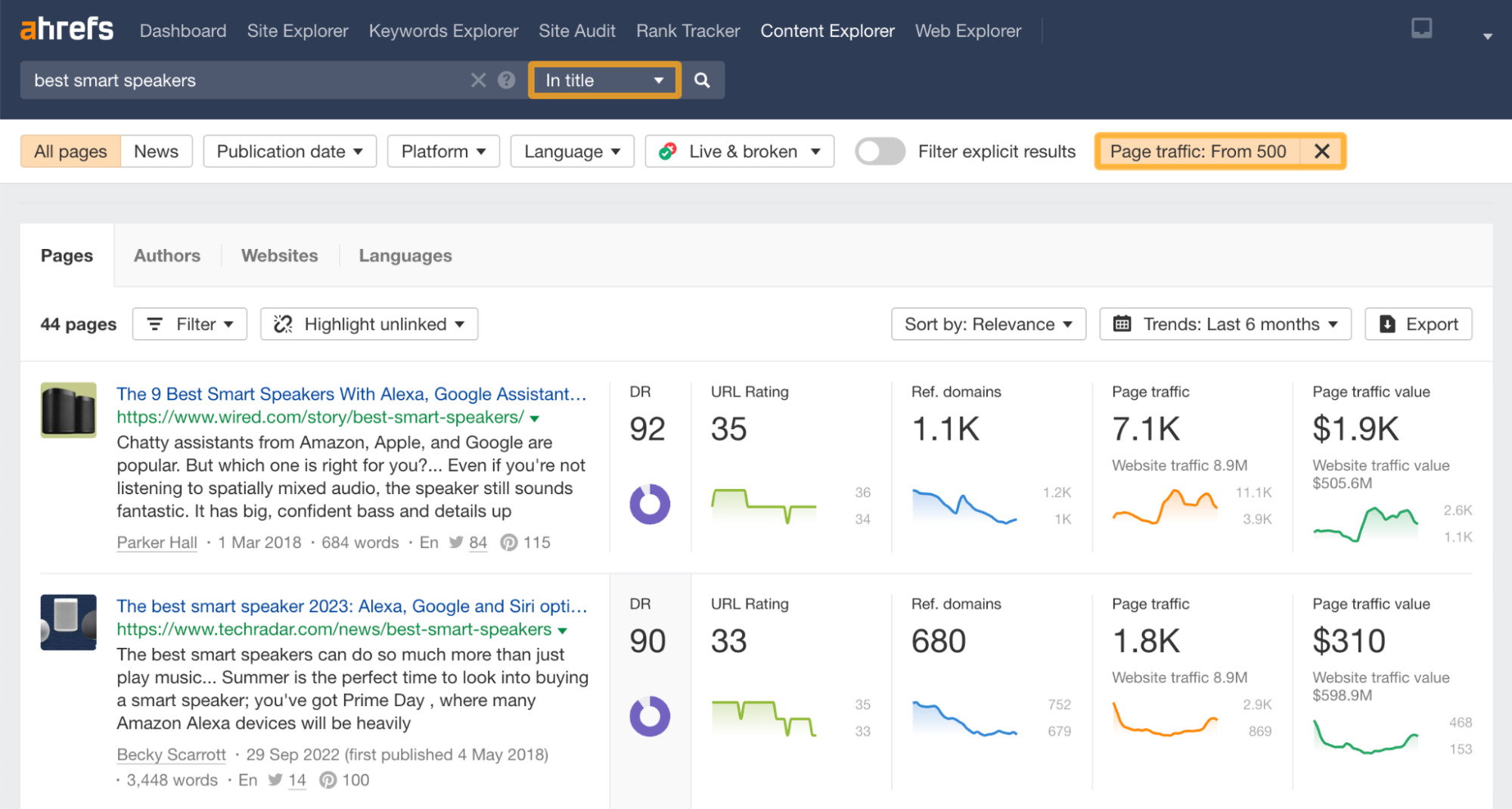
For example, here’s a list of the best smart speakers that don’t mention any Sonos speakers:

If Sonos wants to build more links to one of its smart speaker product pages, it can offer to send the product to the author for free in return for feedback. If the author loves it, Sonos can ask the author if they’ll consider featuring it in their post.
Never explicitly offer to send authors your product in exchange for a link. It could lead to a penalty because Google sees “exchanging goods or services for links” as a link scheme.
Claim unlinked brand mentions in reviews
Unlinked mentions are online mentions of your products or brand without a link to your site.
They can happen for all kinds of reasons. However, they’re often difficult to turn into links because there’s rarely an obvious or compelling pitch angle.
For example, here’s an unlinked mention for Audio-Technica:
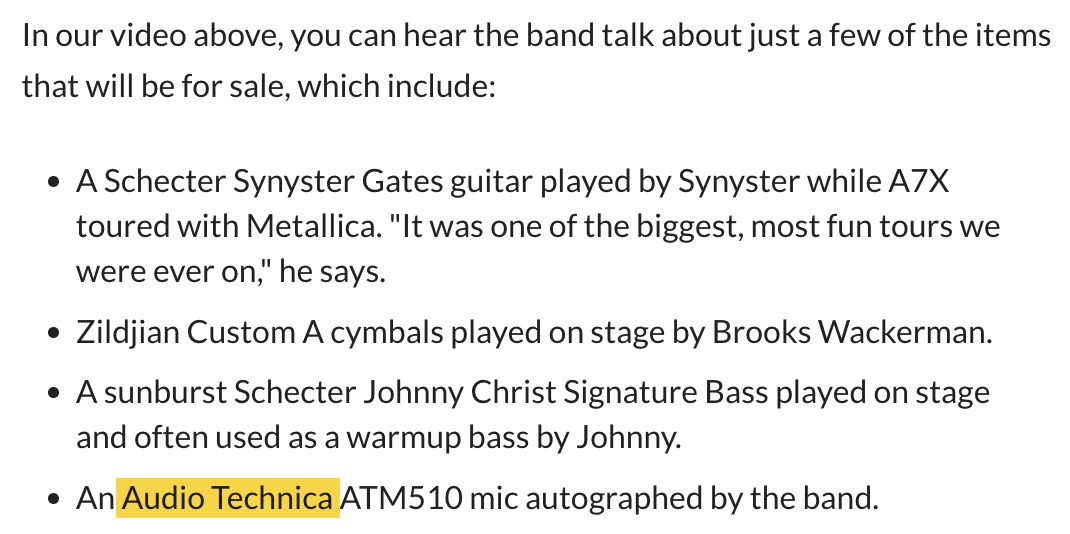
Unfortunately, in this case, there’s no compelling pitch angle. That’s because the unlinked mention is in an article about a band selling gear to fund music education, and there are no links to other mentioned brands.
However, if someone reviews your product and doesn’t link to you, asking them to link to the official product page so readers can learn more about the product is a logical and at least somewhat compelling angle.
You can find unlinked reviews with Ahrefs’ Web Explorer, which searches an index of billions of pages. Just enter this search: Intitle:[your brand] review -outlinkdomain:[yoursite.com] -site:[yoursite.com.
For example, if you wanted to find unlinked reviews for Audio-Technica, you’d search this: intitle:audio technica review -outlinkdomain:audio-technica.com -site:audio-technica.com.

It’s then just a case of reviewing the pages and asking them to add the link where it makes sense. Even if only a few reviewers do this, that’s a few easy links to product pages.
Use HARO to get high-authority links to your ecommerce store
HARO (Help a Reporter Out) is a service that connects journalists and bloggers with sources.
If you sign up as a source (free), HARO sends you daily emails with requests like this:
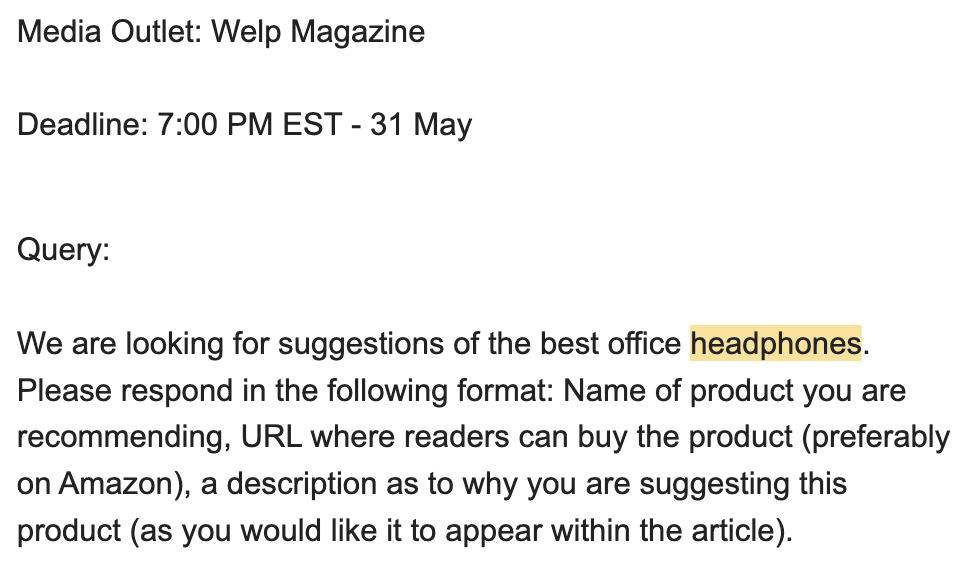
In this case, the blogger wants recommendations for the best office headphones.
If we plug their website (Welp Magazine) into Site Explorer, we see it’s a Domain Rating (DR) 59 site with plenty of organic traffic. So it’s certainly worth pursuing the link as part of our link building strategy.

Even better, we know the blogger will link to those they feature because their request says this:

Long story short, we could probably get a link from this site by sending our recommendation to the blogger along with the other details they want.
Capturing the attention of your audience is vital in ecommerce. By creating valuable, relevant, and engaging content, you can enhance your online store’s visibility, build customer relationships, and drive more conversions.
Let’s consider a few of the top priorities in content marketing for ecommerce sites.
Find commercial investigation keywords to target with blog posts
Commercial investigation keywords are terms people are searching for when researching what to buy.
For example, if you search for “best wireless headphones” on Google, it’s likely you are ready to buy a good pair of wireless headphones.
Identifying “best” product searches is a simple way to start finding commercial intent keywords.
The easiest way to do this is to:
- Enter your keyword into Keywords Explorer.
- Add an Include filter containing the word “best.”
- Apply the filter and hit Show results.

We can see from this quick search that Ahrefs has identified over 9,396 keywords we can potentially use.
As well as “best” keywords, you can also find commercial intent in questions. For example, if you were to search for “how do noise canceling headphones work,” chances are you’d be interested in buying a pair.
In Keywords Explorer, you can find these types of keywords in the Questions section after you’ve plugged in your keyword.
Here’s a quick example of an informational keyword for “noise canceling headphones.”

Remember to look for keywords relating to problems that your products help to solve.
For example, keywords like “how to clean headphones” don’t work because the searcher isn’t in the market for new headphones. But keywords like “how to fix broken headphones” may work because most headphones aren’t easily fixable—so a new pair might be the best solution.
Once you understand the psychology behind commercial intent keywords, you’re ready to create product-led content for your ecommerce site as part of your SEO strategy.
Create product-led content to attract more customers to your ecommerce site
Product-led content helps readers solve their problems using products you sell. Creating this content around keywords people are searching for can attract more potential customers from the search engine results to your ecommerce website.
For example, this blog post about fixing headphones that only work in one ear gets an estimated 13.3K monthly search visits:

It explains how to fix common issues before recommending new, durable headphones for readers who didn’t manage to get things working.

In this case, the site recommends products on Amazon. But there’s no reason you can’t recommend and link to your product pages in these articles.
Optimize your product images for search to get more clicks
Google Images is the world’s second-largest search engine. It’s responsible for over 20% of all online searches.
So when potential customers are searching for your products, it’s likely they’ll browse through it to find the product they’re looking for.

If you want to appear at the top of Google Images search results, you’ll need to start by optimizing your ecommerce site’s product pages and images for SEO.
You’ll then need to add a descriptive filename separated by hyphens. Try to keep your filename to the point and remember to include important keywords, like the example below:

Then add descriptive alt text to your image. Alt text is code that looks like this:
<img alt="your alt text description goes here">
So, for example, for these headphones, the alt text can be:
<img alt="Apple AirPods Max in silver">
These days, most content management systems (CMSs) will have the option to add alt text when you’re uploading images, so you won’t need to edit the code manually.
You should make your alt text as succinct as possible. Here’s an example from Apple, where the alt text reads: “Front view of AirPods Max in Silver.”

Although the principles of alt text are easy to understand, it’s easy to forget to add it. A lot of websites will have at least a few images that have missing alt text on them.
The fastest, free way to check your site for missing alt text is to use a tool like Ahrefs Webmaster Tools.
Once you’ve run a crawl of your site using the tool, head to the overview in Site Audit to see if there are any issues.
Here’s an example of a site with 2,712 images with missing alt text.

Clicking through on the “Missing alt text” issue takes you to the affected URLs. You can then order the list by clicking on “Organic traffic” to prioritize the pages already performing well in search.

If the page already has high organic traffic, it’s likely the images on that page can perform well in Google Images.
Once you’ve optimized your images, you can monitor the clicks they get by clicking on “Performance” and then selecting the search type as “Image.”
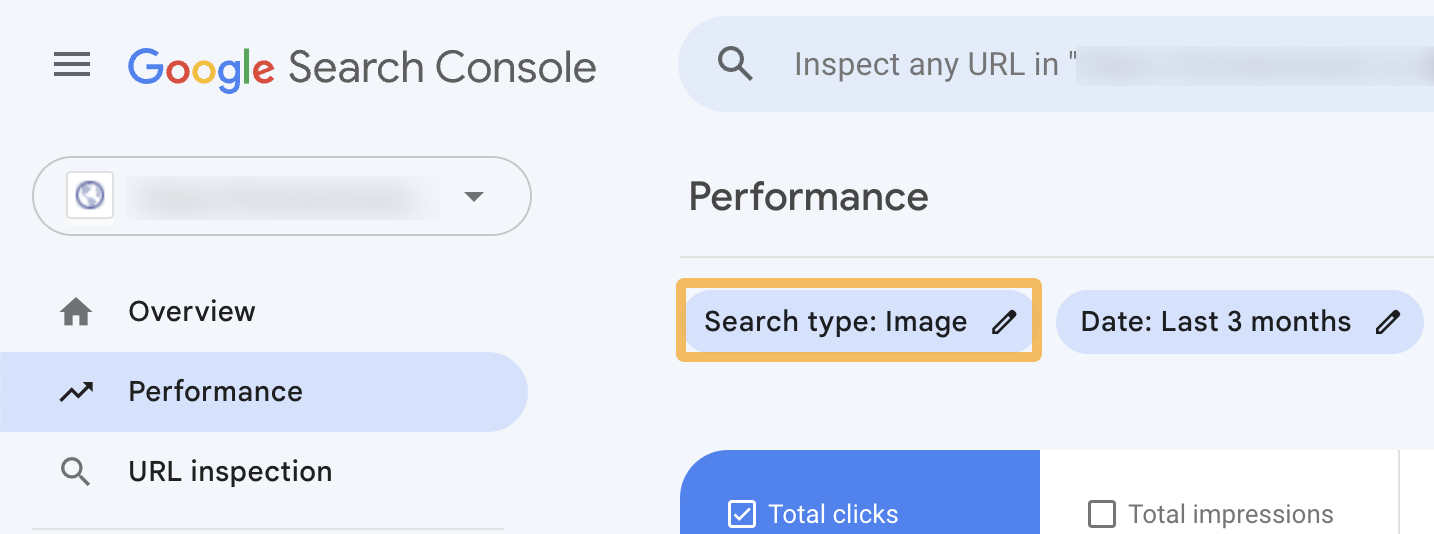
Everything above will get you off on the right foot with ecommerce SEO. But there are other things you can do to attract even more search engine traffic and sales. Let’s go through some of them.
Index faceted URLs with search demand to get more clicks
People search for products in many ways, so you’ve probably come across terms during keyword research that didn’t make sense for subcategories. But if you have faceted navigation on your store, you likely already have parameterized URLs targeting many of these terms.
For example, there are an estimated 150 monthly searches for “jabra over ear headphones” in the U.S.:

If you sell these products and let visitors filter for them using faceted navigation, they’ll probably end up at a URL like this:
/headphones?brand=jabra&design=over-ear
Since most ecommerce stores canonicalize faceted URLs to a master category or subcategory, this URL probably isn’t indexable. However, you can fix that by changing the canonical to a self-referencing one.
If you do this for all faceted URLs with search demand, you often attract more search traffic without creating any new content.
Here’s a cheat sheet from Aleyda Solis to help you figure out which ones to index:
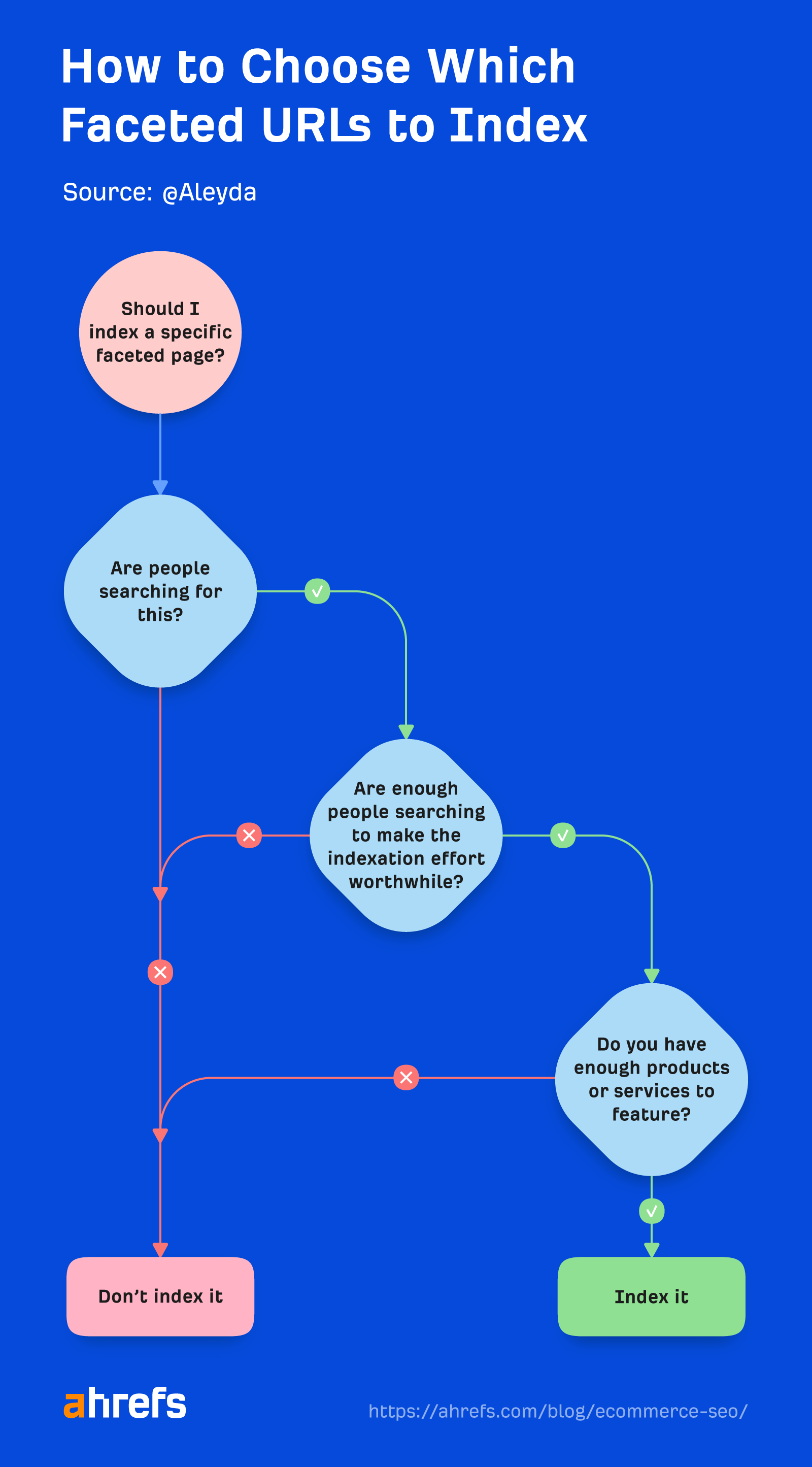
If you notice people searching for product attributes you don’t have filters for, consider adding them. For example, there are many searches for headphones compatible with various devices:

You can easily add a “Compatible with” set of filters and index relevant faceted URLs to attract search traffic from these terms.
Add schema markup to product pages to win rich snippets
Schema markup is code that helps search engines better understand and showcase your pages in the search engine results pages (SERPs). Adding it to product pages can help them win rich snippets like this:

Here’s what the schema markup can look like for a page selling AirPods Pro:
<script type="application/ld+json">
{
"@context": "https://schema.org/",
"@type": "Product",
"name": "AirPods Pro",
"image": "",
"brand": {
"@type": "Brand",
"name": "Apple"
},
"offers": {
"@type": "Offer",
"url": "",
"priceCurrency": "USD",
"price": "249",
"availability": "https://schema.org/InStock",
"itemCondition": "https://schema.org/NewCondition"
},
"aggregateRating": {
"@type": "AggregateRating",
"ratingValue": "4.9"
}
}
</script>It tells Google the product’s name, brand, price, review rating, and if it’s in stock.
There are plenty of free schema markup generators like this one, so you don’t have to write the code by hand. Some ecommerce platforms also have the option to add built-in schema markup.
Link to important subcategories to highlight them for visitors (and search engines)
Linking to important subcategories from your category pages prioritizes the links that visitors are most likely to be interested in.
This makes it easier for your store’s visitors to navigate around your ecommerce website.
Here’s an example where important subcategories have been highlighted near the top of the category page.

This design allows visitors to get to the subcategories they want to quickly. It’s also helpful for mobile users, as it means they don’t have to scroll through thousands of products.
It’s also possible that the location of these links may boost the authority of these subcategory pages, according to the reasonable surfer model established in Google’s patents.
Here’s another example where another retailer has linked to popular subcategories at the top of the category page.

Monitor technical SEO issues to avoid unexpected traffic drops on your ecommerce website
A solid technical foundation helps you avoid common issues that often plague ecommerce stores. But technical SEO isn’t a one-time thing. New problems will arise over time.
That’s why monitoring your technical SEO health and fixing issues on ecommerce websites should be part of your ecommerce SEO strategy. To do this you need the best ecommerce SEO tools.
Using Site Audit with an Ahrefs Webmaster Tools account, you can do this for free. It monitors for 100+ common SEO issues, including those you often see on ecommerce sites, like duplicate content, canonicalization issues, and orphan pages.

You can schedule daily, weekly, or monthly crawls to stay on top of issues.
Here are a few examples of common issues that can affect ecommerce websites and hurt rankings.
- Not including breadcrumbs – Visitors (and Google) find breadcrumbs on ecommerce websites useful.
- Forgetting to add schema markup – Adding schema can help you win rich snippets.
- Indexing low-quality pages – Indexing ecommerce filters or search pages that don’t add any value.
- Keyword stuffing – Repeatedly mentioning your keywords on your website.
- Blocking key pages of your website – Sometimes,
noindextags or “Disallow” directives in robots.txt can be added by mistake, meaning pages don’t show in Google. - Having a slow site - Your customers won’t like a slow site and it could impact conversions if you don’t optimize for site speed, especially if they are browsing your site on a mobile device
I don’t have a crystal ball to predict exactly what the future will look like for ecommerce SEO, but here are some thoughts.
With Google starting to incorporate generative AI into its search experience, it’s likely that search and ecommerce SEO will evolve into a different experience from what we have today.
Here’s an example of what the SERPs look like today for a search for “bluetooth headphones.”

If we ignore the “People also ask” results, the rest are category pages from ecommerce stores.
Now take a look at the SERP for this same search under Google’s AI-powered Search Generative Experience:
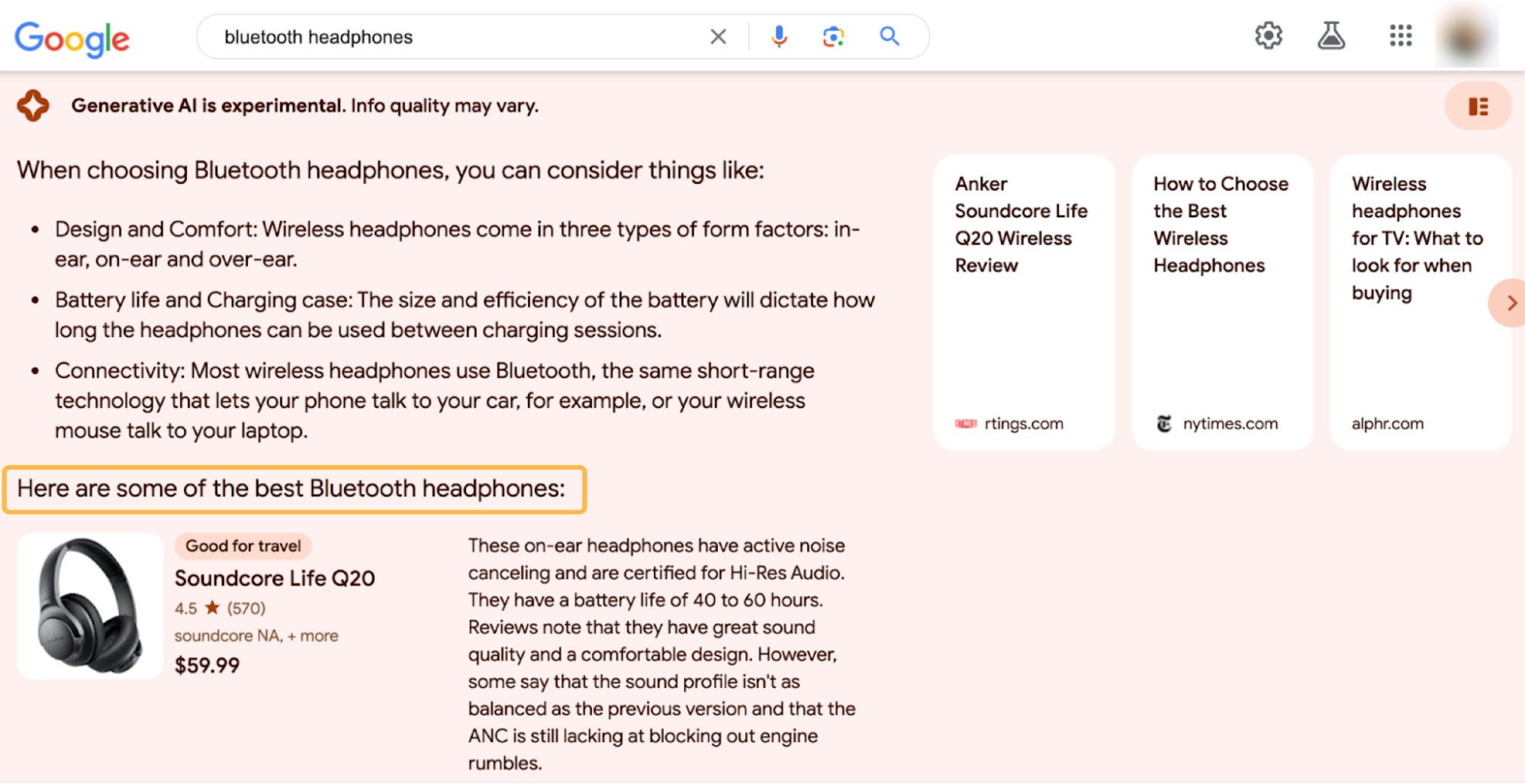
With this result, Google’s effectively generated its own category page right there on the SERP.
If this change becomes reality, it’s possible that the future of ecommerce SEO could shift its focus more to optimizing product pages.
Aleyda also talked about these potential changes and her predictions for ecommerce SEO.
Final thoughts
Ecommerce SEO is far from straightforward. Getting the basics right is easy enough, but catering to search demand while avoiding common technical issues is often more complicated than you think.
Here are a few helpful resources to learn more about those issues:



